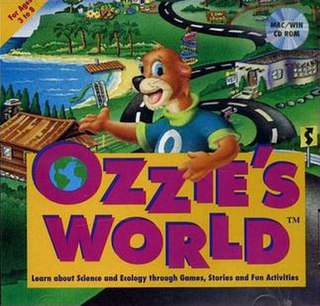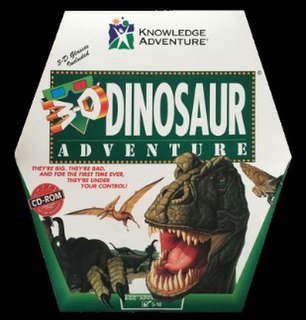
Living Books is a series of interactive read-along adventures aimed at children aged 3–9. Created by Mark Schlichting, the series was mostly developed by Living Books for CD-ROM and published by Broderbund for Mac OS and Microsoft Windows. Two decades after the original release, the series was re-released by Wanderful Interactive Storybook for iOS and Android.

The Satellite was a line of laptops manufactured by Toshiba's computer subsidiary now known as Dynabook Inc. Models in the Satellite family varied greatly—from entry-level models sold to consumers at major retailers to full-fledged business laptops sold through enterprise channels. The latter were marketed as the Satellite Pro.

The Sony Multimedia CD-ROM Player was a portable CD-ROM-based multimedia player produced by Sony and released in 1992. It was used to run reference software, such as electronic publications and encyclopedia. Before its release, both Sony representatives and the press referred to the device as the Sony Bookman; that name remained in use in later publications.

Jewels of the Oracle is a 1995 adventure game developed by ELOI Productions and published by Discis Knowledge Research Inc. It was released on Macintosh, PlayStation, Sega Saturn, and Windows. A sequel developed by Bardworks and published by Hoffman and Associates was released in 1998 entitled Jewels II: The Ultimate Challenge.

Ozzie is a series of children's educational games developed by Tulsa, Oklahoma studio Digital Impact. They all star Ozzie S. Otter, a curious and imaginative young 7-year-old orphaned sea otter pup who serves as the series' main protagonist. The games focus on teaching children science and ecology in different environments. They also include several activities, stories, mini games and experiments to try out.

A Passion for Art: Renoir, Cezanne, Matisse, and Dr. Barnes is a 1995 interactive CD-ROM by Corbis.
Microsoft Art Gallery is a 1993 educational and interactive guide for the London National Gallery published by Microsoft.

A.D.A.M. The Inside Story is a 1995 scientific educational interactive CD-ROM. It was one in a series of titles made in collaboration between Columbia/HCA Healthcare Corporation and A.D.A.M. Software, alongside titles such as A.D.A.M. Life's Greatest Mysteries and A.D.A.M. Nine Month Miracle.

3-D Dinosaur Adventure is an educational video game by Knowledge Adventure released on CD-ROM for MS-DOS compatible operating systems in 1993. Versions for Macintosh and Windows 3.x were published in 1996. A 1997 re-release for Macintosh and Microsoft Windows is titled 3-D Dinosaur Adventure: Anniversary Edition.
Isaac Asimov's Science Adventure is an educational interactive CD-ROM. The game was later updated as Isaac Asimov's Science Adventure II. It is part of Knowledge Adventure's Adventure series.

Titanic: Challenge of Discovery is a video game developed by Maris Multimedia's Moscow studio and published by Panasonic Interactive Media on Aug 24, 1998 for Windows.
The Residents: Freak Show is a CD-ROM by The Voyager Company. A few years earlier they had released a similar work based on The Residents entitled Twenty Twisted Questions. The project was spearheaded by James Ludtke.
Microsoft Ancient Lands is a 1994 "infotainment" multimedia software title, part of the Microsoft Home series, covering the ancient civilizations of Egypt, Greece, and Rome. It featured 21 animations and video sequences and 5 hours of video, and allowed users to learn about aspects of life like cooking and working.
Nickelodeon Director's Lab is a movie-making interactive program by Viacom New Media and published by Nickelodeon. A sequel was released called Nickelodeon Multimedia Lab.

Reply Corporation, often shortened to Reply Corp., was an American computer company based in San Jose, California. Founded in 1988 by Steve Petracca, the company licensed the Micro Channel architecture from IBM for their own computers released in 1989, competing against IBM's PS/2 line. The company later divested from offering complete systems in favor of marketing motherboard upgrades for older PS/2s. Reply enjoyed a close relationship with IBM, owing to many of its founding employees, including Petracca, having worked for IBM. The company was acquired by Radius in 1997.

The ActionNote was a series of laptop computers developed by Epson America in 1993. The series was Epson's answer to the small businesses and home office market for laptops and initially ran alongside their corporate-oriented NB series of laptops. The series was segmented into premium and low-cost offerings and included a subnotebook, the ActionNote 4000. The bulk of the laptops' manufacturing was performed by ASE Technologies of Taiwan, with the exception of the short-lived initial entries into the 700 series, which were produced by Jabil Circuit. The ActionNote received mixed, mostly positive, reception in its lifespan before Epson America silently left the personal computer market in 1996.

Canon Computer Systems, Inc. (CCSI), sometimes shortened to Canon Computer, was an American subsidiary of Canon Inc. formed in 1992 to develop and market the parent company's personal computers and workstations. The subsidiary also assumed the responsibility of marketing Canon's printers and photocopiers, which were formerly sold by other Canon divisions. It went defunct in January 2001.
The Compaq Professional Workstation was a family of workstations produced by Compaq. Introduced in late October 1996, the first entry in the family featured single or dual Pentium Pro processors. Later entries featured Pentium IIs and IIIs; the XP1000 was the only non-x86 based entry, featuring a DEC Alpha processor. Compaq aimed the Professional Workstation at computer-aided design users, software programmers, multimedia designers and financial workers. While workers of those fields primarily ran Unix-based operating systems on workstations at the time, the Compaq Professional Workstation came preinstalled with Windows NT 4.0 Workstation. The line was discontinued in 2002.

DTK Computer is the name for international branches of Datatech Enterprises, a Taiwanese computer manufacturer. Founded in 1981, the company was an early supplier of peripherals for IBM PCs as well as PC compatible motherboards. In the late 1980s, the company switched to developing complete systems under the DTK name as well as serving as an OEM for motherboards and cases, as bought by other small computer companies and systems integrators. The company was little-known in its own time but performed well in the marketplace. DTK was the 10th and 11th biggest personal computer manufacturer in the world in 1991 and 1992 respectively, according to Electronics magazine.

DECpc was a wide-ranging family of desktop computers, laptops, servers, and workstations sold by Digital Equipment Corporation. The vast majority in the family were based on x86 processors, although the APX 150 used DEC's own Alpha processor. The line was DEC's first break into the IBM PC compatible market.














